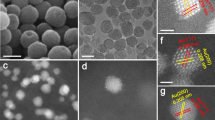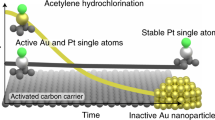Abstract
Oxidation is an important method for the synthesis of chemical intermediates in the manufacture of high-tonnage commodities, high-value fine chemicals, agrochemicals and pharmaceuticals: but oxidations are often inefficient1. The introduction of catalytic systems using oxygen from air is preferred for ‘green’ processing2. Gold catalysis is now showing potential in selective redox processes3,4,5,6, particularly for alcohol oxidation7,8,9,10 and the direct synthesis of hydrogen peroxide11,12. However, a major challenge that persists is the synthesis of an epoxide by the direct electrophilic addition of oxygen to an alkene13. Although ethene is epoxidized efficiently using molecular oxygen with silver catalysts in a large-scale industrial process14, this is unique because higher alkenes can only be effectively epoxidized using hydrogen peroxide15,16,17, hydroperoxides16 or stoichiometric oxygen donors. Here we show that nanocrystalline gold catalysts can provide tunable active catalysts for the oxidation of alkenes using air, with exceptionally high selectivity to partial oxidation products (∼98%) and significant conversions. Our finding significantly extends the discovery by Haruta18,19 that nanocrystalline gold can epoxidize alkenes when hydrogen is used to activate the molecular oxygen; in our case, no sacrificial reductant is needed. We anticipate that our finding will initiate attempts to understand more fully the mechanism of oxygen activation at gold surfaces, which might lead to commercial exploitation of the high redox activity of gold nanocrystals.
This is a preview of subscription content, access via your institution
Access options
Subscribe to this journal
Receive 51 print issues and online access
$199.00 per year
only $3.90 per issue
Buy this article
- Purchase on Springer Link
- Instant access to full article PDF
Prices may be subject to local taxes which are calculated during checkout

Similar content being viewed by others
References
Sheldon, R. A. Heterogeneous catalytic oxidation and fine chemicals. Stud. Surf. Sci. Catal. 66, 33–54 (1991)
Gallezot, P. Selective oxidation with air on metal catalysts. Catal. Today 37, 405–418 (1997)
Bond, G. C. & Thompson, D. T. Catalysis by gold. Catal. Rev. Sci. Eng. 41, 319–388 (1999)
Fu, Q., Saltsburg, H. & Flytzani-Stephanopoulos, M. Active non-metallic Au and Pt species on ceria-based water-gas shift catalysts. Science 301, 935–938 (2003)
Bailie, J. E. & Hutchings, G. J. Promotion by sulfur of gold catalysts for crotyl alcohol formation from crotonaldehyde hydrogenation. Chem. Commun. 2152 (1999)
Mohr, C., Hofmeister, H., Lucas, M. & Claus, P. Gold catalysts for the partial hydrogenation of acrolein. Chemie-Ingenieur-Technik 71, 869–873 (1999)
Biella, S., Prati, L. & Rossi, M. Selectivity control in the oxidation of phenylethane-1,2-diol with gold catalyst. Inorg. Chim. Acta 349, 253–257 (2003)
Biella, S., Prati, L. & Rossi, M. Selective oxidation of D-glucose on gold catalyst. J. Catal. 206, 242–247 (2002)
Carrettin, S., McMorn, P., Johnston, P., Griffin, K. & Hutchings, G. J. Selective oxidation of glycerol to glyceric acid using a gold catalyst in aqueous sodium hydroxide. Chem. Commun. 696–697 (2002)
Carrettin, S. et al. Oxidation of glycerol using supported Pt, Pd and Au catalysts. Phys. Chem. Chem. Phys. 5, 1329–1336 (2003)
Landon, P., Collier, P. J., Papworth, A. J., Kiely, C. J. & Hutchings, G. J. Direct synthesis of hydrogen peroxide from H2/O2 using a gold catalyst. Chem. Commun. 2058–2059 (2002)
Landon, P. et al. Direct synthesis of hydrogen peroxide from H2 and O2 using Pd and Au catalysts. Phys. Chem. Chem. Phys. 5, 1917–1923 (2003)
Monnier, J. R. The direct epoxidation of higher olefins using molecular oxygen. Appl. Catal. A 221, 73–91 (2001)
Boxhoorn, G. Process for the manufacture of silver-containing epoxidation catalysts. European Patent Application (Shell Internationale Research Maatschappij B.V., Neth., Appl. EP 87–201439, 19870727, 1988).
Grigoropoulou, G. & Elings, J. A. Recent developments on the epoxidation of alkenes using hydrogen peroxide as oxidant. Green Chem. 5, 1–7 (2003)
Sheldon, R. A. & Van Vliet, M. C. A. in Fine Chemicals through Heterogeneous Catalysis (eds Sheldon, R. A. & Van Bekkum, H.) (Wiley-VCH, Weinheim, 2001)
Lee, S. et al. Mechanistic insights into the conversion of cyclohexene to adipic acid by H2O2 in the presence of a TAPO-5 catalysts. Angew. Chem. Int. Edn Engl. 42, 1520–1523 (2003)
Sinha, A. K., Seelan, S., Tsubota, S. & Haruta, M. A three-dimensional mesoporous titanosilicate support for gold nanoparticles: vapor-phase epoxidation of propene with high conversion. Angew. Chem. Int. Edn Engl. 43, 1546–1548 (2004)
Sinha, A. K., Seelan, S., Tsubota, S. & Haruta, M. Catalysis by gold nanoparticles: epoxidation of propene. Top. Catal. 29, 95–102 (2004)
Xu, Y.-J. et al. Selective conversion of cyclohexane to cyclohexanol and cyclohexanone using a gold catalyst under mild conditions. Catal. Lett. 101, 175–179 (2005)
Clavilier, J., Feliu, J. M. & Aldaz, A. An irreversible structure sensitive adsorption step in bismuth underpotential deposition at platinum electrodes. J. Electroanal. Chem. 243, 419–433 (1988)
Fordham, P., Besson, M. & Gallezot, P. Selective oxidation with air of glyceric to hydroxypyruvic acid and tartronic to mesoxalic acid on PtBi/C catalysts. Stud. Surf. Sci. Catal. 108, 429–436 (1997)
Brust, M., Kiely, J. K., Bethell, D. & Schriffrin, D. J. C60 mediated aggregation of gold nanoparticles. J. Am. Chem. Soc. 120, 12367–12368 (1998)
Attard, G. A. et al. Electrochemical evaluation of the morphology and enantioselectivity of Pt/graphite. Appl. Catal. A 222, 393–405 (2001)
Acknowledgements
We acknowledge the support of the Engineering and Physical Sciences Research Council (EPSRC) of the UK, Johnson Matthey plc (project ATHENA) and the European Union (project AURICAT). We also thank D. Bethell for discussions on the reaction mechanism. Author Contributions: M.D.H. and Y-J. X. prepared and tested the catalysts under the supervision of P.L., D.I.E. and P.M. C.J.K. made the TEM measurements and A.F.C. the XPS measurements. P. Jenkins prepared the Bi-doped catalysts and made the CV measurements under the supervision of G.A.A. G.J.H. directed the research and wrote the paper. E.H.S., F.K., P. Johnston and K.G. provided discussions and advice on catalyst synthesis.
Author information
Authors and Affiliations
Corresponding author
Ethics declarations
Competing interests
Reprints and permissions information is available at npg.nature.com/reprintsandpermissions. The authors declare no competing financial interests.
Supplementary information
Supplementary Figure 1
Reaction of cyclohexene with O2 in 1,2,3,5-tetramethylbenzene at 80 °C. (DOC 55 kb)
Supplementary Figure 2
Au(4f) and Bi(4f) photoemission spectra obtained for (a) graphite support (b) as prepared Bi-doped 1 wt % Au-graphite catalyst, (c) catalyst after reaction, (d) catalyst in (c) after further reaction with a fresh reactant mixture. (DOC 145 kb)
Supplementary Figure 3
Transmission electron micrograph of a 1% Au/C catalyst. (DOC 51 kb)
Supplementary Table 1
Alkene oxidation with molecular oxygen using Au/C catalysts. (DOC 68 kb)
Supplementary Table 2
cis-Stilbene oxidation with molecular oxygen using a 1% Au/G catalyst. (DOC 46 kb)
Supplementary Table 3
Cyclohexene Oxidation Using Au/G or Sb, Sn and Pb modified gold/G catalyst. (DOC 39 kb)
Supplementary Table 4
cis-Cyclooctene oxidation using 1% Au/carbon catalysts in a glass reactor. (DOC 55 kb)
Rights and permissions
About this article
Cite this article
Hughes, M., Xu, YJ., Jenkins, P. et al. Tunable gold catalysts for selective hydrocarbon oxidation under mild conditions. Nature 437, 1132–1135 (2005). https://doi.org/10.1038/nature04190
Received:
Accepted:
Issue Date:
DOI: https://doi.org/10.1038/nature04190
This article is cited by
-
Scalable and selective gold recovery from end-of-life electronics
Nature Chemical Engineering (2024)
-
Solar-driven green synthesis of epoxides
Science China Chemistry (2023)
-
Catalytic Oxidation of Ethyl Lactate to Ethyl Pyruvate over Au-Based Catalyst Using Authentic Air as Oxidant
Catalysis Surveys from Asia (2022)
-
Dual-atom Pt heterogeneous catalyst with excellent catalytic performances for the selective hydrogenation and epoxidation
Nature Communications (2021)
-
Biosynthesis of Gold Clusters and Nanoparticles by Using Extracts of Mexican Plants and Evaluation of Their Catalytic Activity in Oxidation Reactions
Catalysis Letters (2021)
Comments
By submitting a comment you agree to abide by our Terms and Community Guidelines. If you find something abusive or that does not comply with our terms or guidelines please flag it as inappropriate.



